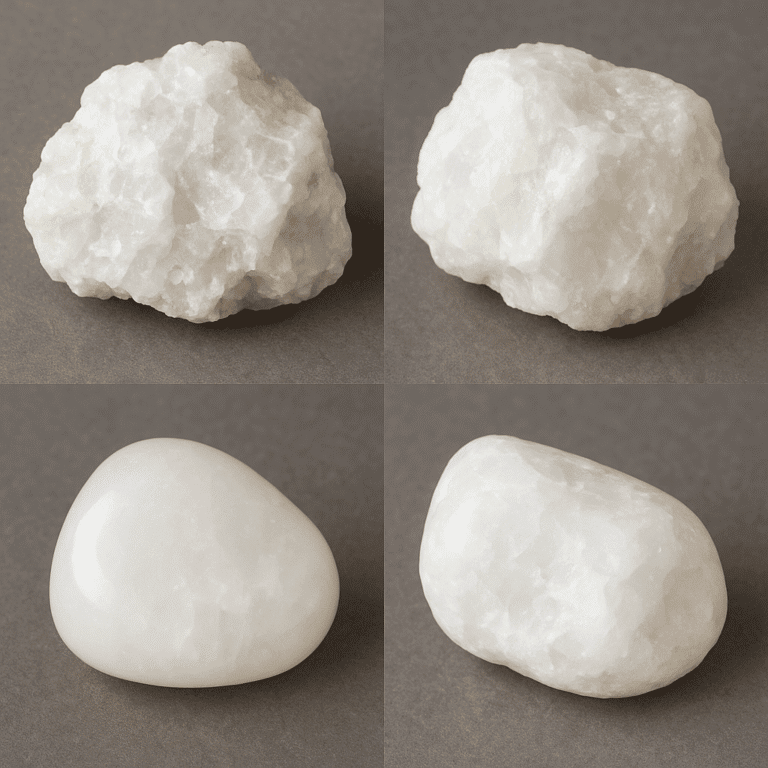December Mineral Spotlight: Snow Quartz (Milky Quartz)
Snow Quartz—often called Milky Quartz—is a frosty, cloud-like variety of quartz that perfectly matches the winter season. Its soft, snowy appearance makes it a favorite among collectors, especially during the colder months when its gentle glow feels right at home. Abundant, durable, and easy to identify, Snow Quartz is a great mineral for both beginners and experienced rockhounds.
What Is Snow Quartz?
Snow Quartz is a white to opaque variety of quartz created by countless microscopic fluid or gas inclusions trapped during formation. These tiny inclusions scatter light, giving the mineral its cloudy, “snowy” appearance. Unlike clear quartz, Snow Quartz has a soft, soothing glow that makes it visually distinct and highly collectible. It appears in massive form, veins, clusters, and tumbled stones.
Key Properties
Chemical Formula: SiO₂
Color: White to translucent; cloudy with swirling patterns
Hardness: 7 on the Mohs scale
Crystal System: Hexagonal
Luster: Vitreous to waxy
Common Forms: Veins, massive chunks, clusters, tumbled stones
Other Names: Milky Quartz, White Quartz
How to Identify Snow Quartz
Snow Quartz is generally easy to recognize thanks to its cloudy, frosted appearance. Here are the best identification tips:
Look for a soft, white, snowy appearance.
Snow Quartz is never clear—its cloudy look is its most defining feature.Check the translucence.
Most specimens allow light to pass through but not clearly.Test the hardness.
Like all quartz, Snow Quartz will scratch glass.Watch for swirling or foggy internal patterns.
These are caused by trapped microscopic inclusions.Feel the surface.
It often has a slightly softer appearance compared to the glassy shine of clear quartz.
Where Snow Quartz Is Found
Snow Quartz is one of the most common minerals on Earth and can be found in many locations where quartz veins are present.
Notable localities include:
Oregon (common in many quartz-rich regions)
Arkansas, USA
Brazil
Switzerland
India
Madagascar
Colorado & California, USA
Snow Quartz is especially abundant in pegmatite zones, old mining areas, river gravels, and glacial deposits.
Why Rockhounds Love Snow Quartz
Snow Quartz may seem simple at first glance, but collectors love it for several reasons:
It’s abundant and easy to find, making it great for beginners.
Its wintery, frosted appearance is visually soothing and perfect for December.
It’s durable, with a hardness of 7, so it tumbles and polishes beautifully.
It has geological teaching value, especially for explaining inclusions and crystal growth.
It comes in many forms, from massive chunks to pretty tumbled stones and clusters.
Collecting Tips
If you want to add Snow Quartz to your collection, keep these tips in mind:
Bring a rock hammer and chisel.
Snow Quartz often appears in veins that need to be pried from host rock.Search quartz-rich areas like road cuts, pegmatites, and old mines.
These environments frequently expose large amounts of vein quartz.Check river and creek gravels.
Snow Quartz is tough enough to survive erosion and transport.Look in glacial deposits.
Glaciers move quartz-bearing rocks over long distances.Try tumbling your finds.
Snow Quartz takes an excellent polish and is great for beginners learning to tumble stones.
Fun Facts
Snow Quartz gets its white color from thousands of microscopic inclusions.
Some specimens show internal “phantoms” or subtle layers.
Ancient cultures carved Snow Quartz into tools, beads, and talismans.
Because of its frosty glow, some collectors call it the “Winter Stone.”
Final Thoughts
Snow Quartz is a humble but beautiful mineral, offering both accessibility and charm. Its peaceful, snowy appearance makes it an ideal choice for December’s Mineral Spotlight. Whether you’re discovering your first specimen or adding new pieces to your growing collection, Snow Quartz is a mineral that brings a sense of winter calm to any rockhounding journey.
